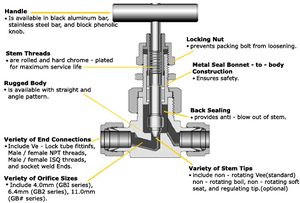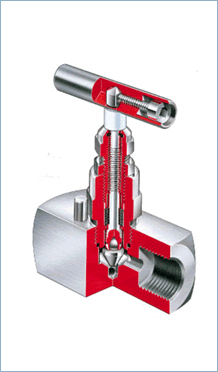Needle Valves
Needle Valves are Valves having a small port and a threaded, needle-shaped plunger. It allows precise regulation of flow, although it is generally only capable of relatively low flow rates.
Construction and operation
A needle valve has a relatively small orifice with a long, tapered seat, and a needle-shaped plunger, on the end of a screw, which exactly fits this seat.As the screw is turned and the plunger retracted, flow between the seat and the plunger is possible; however, until the plunger is completely retracted the fluid flow is significantly impeded. Since it takes many turns of the fine-threaded screw to retract the plunger, precise regulation of the flow rate is possible.
The virtue of the needle valve is from the vernier effect of the ratio between the needle's length and its diameter, or the difference in diameter between needle and seat. A long travel axially makes for a very small and precise change radially . Needle valves may be used in vacuum systems, when a very precise control of gas flow is required, at low pressure,such as when filling gas-filled vacuum tubes,gas lasers and similar devices.
Uses
Needle valves are usually used in flow metering applications, especially when a constant, calibrated, low flow rate must be maintained for some time, such as the idle fuel flow in a carburetor.Note that the float valve of a carburetor is not a needle valve, although it is commonly described as one. It uses a bluntly conical needle, but it seats against a square-edged seat rather than a matching cone. The intention here is to obtain a well-defined seat between two narrow mating surfaces, giving firm shutoff of the flow from only a light float pressure.
Since flow rates are low and many turns of the valve stem are required to completely open or close, needle valves are not used for simple shutoff applications. Since the orifice is small and the force advantage of the fine-threaded stem is high, needle valves are usually easy to shut off completely, with merely finger tight pressure. The spindle and/or seat of a needle valve, especially one made from brass, are easily damaged by excessive turning force when shutting off the flow.
Small, simple needle valves are often used as bleed valves in hot water heating applications. Unlike Ball Valves, or valves with a rising stem, it is not easy to tell from examining the handle position whether the valve is open or closed.

